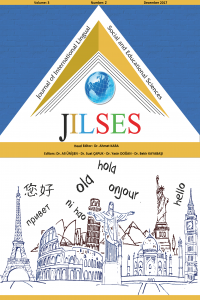Abstract
Bu çalışma, Anadolu erkeklerindeki yüz
ve burun tiplerine göre yaşla ilişkili değişiklikleri tanımlamak ve
karşılaştırmak amacıyla yapıldı; genç, yetişkin ve yaşlı olan üç gruba ayrıldı.
Rastgele örnekleme yöntemi kullanılarak seçilen erkekler (yaşları 20-40
arasında 100, 40-60 yaş 100 ve 60 yaş ve üzeri 100 kişi) toplam 300 sağlıklı
gönüllü erkek seçildi. Bütün erkekler, Frankfurt yatay düzleminde, aynı
fotoğraf makinesinde ve aynı uzaklıktan (1,5 metre) fotoğrafları çekildi. Tüm
fotoğraflar, Image J programı kullanılarak ölçümleri yapıldı Tüm bireylerde
klasik yüz ve burun indeksi hesaplandıktan sonra en fazla yüz ve burun tipi
olarak hiperleptoprosopik tip (% 48, 48 ve 62) ve orta burun (% 59, 48 ve 48)
olduğu gözlendi. Yüz tiplerinin yaş gruplarına dağılımına bakıldığında gruplar
arasında istatistiksel olarak anlamlı farklılık yoktu (p = 0,130). Genç erişkin
grup% 22 dar,% 59 orta ve% 19 geniş burun idi; yetişkin grupta% 14 dar,% 48
orta,% 35 geniş ve % 3 çok geniş burun vardı ve yaşlılar için% 17 dar,% 48
orta,% 29 geniş ve% 6 çok geniş burun vardı. Burun tiplerinde yaş gruplarına
göre istatistiksel olarak anlamlı farklılıklar vardı (p = 0,046). Bu çalışmada
toplanan veriler, normal büyüme, gelişme ve yaşlanma sırasında insan yüzü ve
burun morfolojisi için bir veri tabanı görevi görebilir. Ortofasiyal cerrahi
planlaması, kraniyofasiyal alterasyon, yüz rekonstrüksiyonu ameliyatı, kişisel
kimlik bilgilerindeki adli antropoloji, yaşa dayalı veri bankalarında da
faydalanabilir.
References
- Bertillon, A. Identification anthropom´etrique; instructions signal´etiques. Impr. administrative, (1893) Melun
- Corrucini, R. S. Shape in Morphometrics: Comparative Analyses. American Journal of Physical Anthropology, (1987) 73: 289-303.
- Çırak A., Karaöz Arınan S., Erkman A.C., Çırak M.T., Epigenetic features of Human Skulls from Datca- Burgaz Excavations", Mediterranean Archaeology and Archaeometry (MAA), (2014) 14:1, 13-24.
- Garip B., KTÜ Öğrencileri Arasında Doğu Karadeniz Bölgesi Kökenli Olanların Burun Analizi Yüksek Lisans Tezi, Karadeniz Teknik Üniversitesi Sağlık Bilimleri Enstitüsü Anatomi Anabilimdalı, (2005), Trabzon.
- Günay,I., Şarbak, A., Bibliography of Human Osteology Studies in Turkey (1930-2014), Sch. J. Arts. Humanit. Soc. Sci., August (2015); 3(5A):1003-1026 Kleinberg, Krista F. Facial anthropometry as an evidential tool in forensic image comparison. PhD thesis, (2008).
- Kumar A, et. al. Automated human identification using ear imaging. Pattern Recognition,;45(3): (2011) 956-968. Available from: http://dx.doi.org/10.1016/j.patcog.2011.06.005,2011.
- Mommaerts MY, Moerenhout BA. Ideal proportions in full face front view, contemporary versus antique. J Craniomaxillofac Surg. 2011 Mar;39(2):107-10.
- Özkoçak, V., Alkaya A., Geometrik Morfometride İstatistiksel Yaklaşımlar, Gazi Kitabevi, Number of prints:1, ISBN:978-605- 344-516- 6, Türkçe (Bilimsel Kitap), (2017); Public. Number: 3527664.
- Peer, P. Cvl face database, Computer vision lab.,faculty of computer and information science, University of Ljubljana, (2005), Slovenia.
- Pete E. Lestrel. “Fourier descriptors and their applications in biology. (1997), Cambridge Univ. Press.
- Uzun A, Ozdemir F. Morphometric analysis of nasal shapes and angles in young adults. Braz J Otorhinolaryngol. 2014;80(5):397-402.
Abstract
This study was aimed to describe and compare to age related changes
facial and nasal types in Anatolian men; who were young adult, adult and
elderly of three groups. A total of 300 healthy volunteer men (100 between
20-40 years; 100 between 40-60 years and 100 60-up years) were selected using
random sampling method. All of the men were taken photograph in the Frankfurt
horizontal plane position, same photographic machine and distance (1.5 meter).
All the photos were measured by using Image J programme. After calculating
classic facial and nose index for all subjects the most facial and nose type
were hyperleptoprosopic type (%48, 48 and 62) and medium nose (%59, 48 and 48). There were no
statistically significant differences in face types according to age groups
(p=0,130). The young adult group were %22 narrow, %59 medium and %19 broad
nose; for adult group were %14 narrow, %48 medium, %35 broad and %3 very broad
nose and for the elderly group were %17 narrow, %48 medium, %29 broad and %6
very broad nose. There were statistically significant differences in nose types
according to age groups (p=0,046). Data collected in the present study could
serve as a data base for the human facial and nasal morphology during normal
growth, development and aging. Orthofacial surgery planning, craniofacial
alteration, facial reconstruction surgery, forensic anthropology in personal
identification may also useful from age based data banks.
Keywords
References
- Bertillon, A. Identification anthropom´etrique; instructions signal´etiques. Impr. administrative, (1893) Melun
- Corrucini, R. S. Shape in Morphometrics: Comparative Analyses. American Journal of Physical Anthropology, (1987) 73: 289-303.
- Çırak A., Karaöz Arınan S., Erkman A.C., Çırak M.T., Epigenetic features of Human Skulls from Datca- Burgaz Excavations", Mediterranean Archaeology and Archaeometry (MAA), (2014) 14:1, 13-24.
- Garip B., KTÜ Öğrencileri Arasında Doğu Karadeniz Bölgesi Kökenli Olanların Burun Analizi Yüksek Lisans Tezi, Karadeniz Teknik Üniversitesi Sağlık Bilimleri Enstitüsü Anatomi Anabilimdalı, (2005), Trabzon.
- Günay,I., Şarbak, A., Bibliography of Human Osteology Studies in Turkey (1930-2014), Sch. J. Arts. Humanit. Soc. Sci., August (2015); 3(5A):1003-1026 Kleinberg, Krista F. Facial anthropometry as an evidential tool in forensic image comparison. PhD thesis, (2008).
- Kumar A, et. al. Automated human identification using ear imaging. Pattern Recognition,;45(3): (2011) 956-968. Available from: http://dx.doi.org/10.1016/j.patcog.2011.06.005,2011.
- Mommaerts MY, Moerenhout BA. Ideal proportions in full face front view, contemporary versus antique. J Craniomaxillofac Surg. 2011 Mar;39(2):107-10.
- Özkoçak, V., Alkaya A., Geometrik Morfometride İstatistiksel Yaklaşımlar, Gazi Kitabevi, Number of prints:1, ISBN:978-605- 344-516- 6, Türkçe (Bilimsel Kitap), (2017); Public. Number: 3527664.
- Peer, P. Cvl face database, Computer vision lab.,faculty of computer and information science, University of Ljubljana, (2005), Slovenia.
- Pete E. Lestrel. “Fourier descriptors and their applications in biology. (1997), Cambridge Univ. Press.
- Uzun A, Ozdemir F. Morphometric analysis of nasal shapes and angles in young adults. Braz J Otorhinolaryngol. 2014;80(5):397-402.
Details
| Journal Section | Articles |
|---|---|
| Authors | |
| Publication Date | December 25, 2017 |
| Submission Date | November 15, 2017 |
| Acceptance Date | December 15, 2017 |
| Published in Issue | Year 2017 Volume: 3 Issue: 2 |

This work is licensed under a Creative Commons Attribution-NonCommercial-ShareAlike 4.0 International License.


